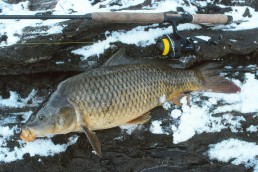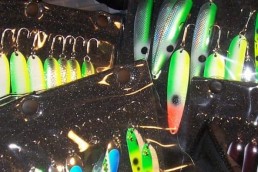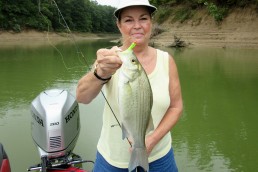Carpin’ Cure for Cabin Fever
SHARE THIS POST
It’s cabin fever time for anglers. While there still may be some ice-fishing opportunities, many anglers yearn for open-water fishing. Mistakenly, they think that catching big fish from ice-free waters is a long time away. Surprisingly, there is plenty of open-water action available almost all winter. Not only can numbers of fish be caught, but lunkers exceeding 10 and 15 pounds are not uncommon. I am talking about catching Cyprinus carpio, commonly named carp. Found throughout the state, they are quite willing to bite and fight hard even when there is snow on the ground. However, correct winter methods must be employed to entice and catch these battling leviathans.
Where to catch the carp
Of course, open water is the starting point. Often, area ponds and reservoirs are ice covered. Unless a prolonged arctic freeze has occurred, many of the rivers and large creeks have open water. This is because moving water freezes last and thaws first. Even in very cold conditions, waters beneath a dam can have open water. The trick is finding pools of calm water. Don’t overlook warm-water discharges. Being cold blooded, carp don’t want to expend energy battling a current in near-freezing waters.
A good spot to look for carp is a stream where people feed ducks and geese. Trust me, none of the bread goes to waste. Bread not eaten by the waterfowl is devoured by carp that hunker downstream from the feeding ducks. This, in effect, chums the fish in. Fish the pool closest to the duck-feeding area.
There is one other item that makes for a good winter carp stream. That is a river with some effluent. A sewage treatment plant or a factory that discharge into the stream causes the river to need extra-cold weather to freeze the water. It has open water when other rivers are frozen over.
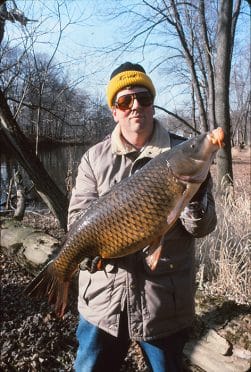
Rig light for a better bite
Now, do not rig up with heavy sinkers and extra big hooks. Often a pickup can’t be detected using traditional methods. These cold-water carp are very, very sensitive to the slightest pressure. Line watching is a critical piece to catching these light biters. Try a highly visible chartreuse, red or golden main line in 10 or 12-pound test. Cast out the bait and prop up the rod in a Y branch. Leave some slack in the monofilament and watch the line bow for any twitches. When the carp mouths the bait, gently pick up the rod. Place your index finger on the line. Set the hook when a tap-tap is felt.
On the end of the main line, attach a 3-foot leader of 10 or 12-pound-test fluorocarbon. It not only is nearly invisible but is tough when fighting a big fish in icy winter conditions. Join the fluorocarbon leader to the main line with a blood knot or a size 10 Spro ball bearing swivel.
Take about a 1/4-inch metal spring and place it over the shaft of a size 6 or 8 Eagle Claw Lazer treble hook. These are super sharp and hook anything that comes close to them. Tie the treble hook to the end of the fluorocarbon.
Baits that tempt bites
Now, comes the piece de resistance, the bait. It is simple, yet deadly. Start with white, squishy bread, such as Wonderbread. Next, get a bottle of anise oil. Yes, it is a bit pricey. So, let me show my cheaper side. Take a bottle of vegetable oil used for cooking. Dump all the anise oil in it. This makes a quart of fish attractant.
Are you enjoying this post?
You can be among the first to get the latest info on where to go, what to use and how to use it!
While streamside, dab the anise/vegetable oil on three or four different sections of a bread slice. Dip the scented bread into a plastic bag containing white flour and salt. Everything likes a salty taste. The white flour makes a paste that helps hold the bread together on the hook in the water. Take the floured bread and tear off about a third of the slice. Wrap it in a ball around the treble hook and squeeze it. The spring helps to hold it on the hook. Next, dip the bread ball quickly into the river water and firmly squish all the water out of it. Be careful of the super-sharp Lazer treble hooks.
Toss it out into the pool’s calm waters. A prime spot is the slack water next to the current break. If the line starts drifting in the water, move it a couple feet closer to the shore. If it needs a weight, add a #3 split shot onto the hook’s knot. If the weight is part of the hook and bait, it feels natural when the carp sucks it in. If more weight is needed, add a slightly larger split shot. However, less weight is best. Often, squeezing all the water out lets the bread ball sink to the bottom. If there is a tap and the fish doesn’t pick it up, or nothing hits the bread ball after 15 to 20 minutes, bring it in. Bait with a new dough ball. The hook is often bare.
If panfish keep nibbling the dough ball off, form a bread ball around the treble. Wrap 3”X 3” steelhead spawn sac material around it. Hook the mesh’s corners to the treble-hook points.
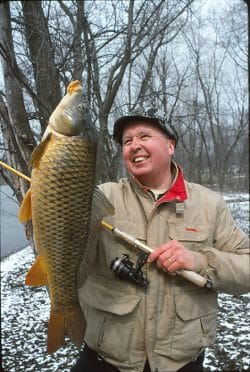
Corn chum for quicker catches
If working an area that isn’t fed by duck lovers, go to the carp hole in the morning. Chum it by broadcasting the contents of several cans of corn into the pool. Salted corn is best. Later in the afternoon, when it warms up, go carp fishing. The corn chum will draw in numbers of carp that will eat your bread dough balls. On a second rod, hook a kernel of canned corn on each of a treble’s hooks. Make certain that this type of chumming is legal in your state.
Before fishing and during the day, keep checking your drag’s pull. A correctly set drag is critical. Even in the cold water, a big carp can break the line when the reel’s drag is set too tightly. A long rod, eight-foot or longer, is an asset when winter carp fishing. It’s length makes it easier to lob-cast a lightly weighted bread ball. Also, the long rod is critical when there is an ice shelf. After hooking the carp, keep the rod tip up in the air as high as possible. Keep the line from rubbing against the edge of the ice. Where possible, work your way up the bank to increase the line’s angle to the fish.
When the fish tires, now comes the fun part, landing it. Tighten the drag, but still allow it to grudgingly give some line. While holding the rod high, put pressure on the fish. If all works out correctly, eventually its head comes out of the water. At this time, really pressure it. Usually this causes the carp to lash its tail back and forth. If all goes well, the carp’s swimming tail along with added fishing rod pressure shoots it onto the ice. Now, simply slide it across the frozen surface to the shore. Some really big carp can be landed this way. Do not walk onto the ice shelf because it can break off.
Oh yes, my favorite carp rods are custom made by my car door. The door has turned a couple of my 10.5-inch noodle rods into 9 footers, perfect size for carp fishing.
This winter, if looking for a cure for cabin fever, why not try a good dose of Cyprinus carpio? It’s a great antidote to winter blues.
MWO
SHARE THIS POST
Did you enjoy this post?
You can be among the first to get the latest info on where to go, what to use and how to use it!
Paul Liikala
Paul Liikala was raised on a farm which was close to Lake Erie and the Grand River. He was fortunate to have parents who nurtured his love for the outdoors. His only hope is that his writings show the love and admiration that he has for the Great Outdoors and its participants.
